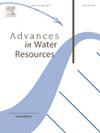Dynamics of fluid flow in natural fracture networks
IF 4.2
2区 环境科学与生态学
Q1 WATER RESOURCES
引用次数: 0
Abstract
In complex fracture networks, dynamic fluid-flow patterns arise already at flow velocities in the centimetre-per-second (cm/s) range. Yet, these phenomena get ignored or underestimated when such flows are modelled using Stokes’ equation or the steady-state Darcy’s law approximations of the Navier–Stokes equation (NSE).
Here we apply Detached-Eddy Simulation to solve the NSE in interconnected rock fractures, carrying out an investigation of transient flow phenomena. Our field-data-based numerical simulation-derived results reveal that fracture flow becomes unsteady at cm/s velocities. Dynamic eddies emerge across several length scales, increasing the tortuosity of the flow and altering the fluid distribution in fracture branches. Pressure fluctuations are detectable at the network scale, reaching magnitudes of of the total pressure drop. The contribution of inertial losses to the hydraulic head gradient across the network increases substantially with the onset of non-stationary eddies, confirming that they are the primary source of flow nonlinearity.
天然裂缝网络中的流体流动动力学
在复杂的裂缝网络中,动态流体流动模式已经在厘米/秒(cm/s)范围内出现。然而,当使用Stokes方程或Navier-Stokes方程(NSE)的稳态达西定律近似来模拟这种流动时,这些现象被忽略或低估了。在这里,我们应用分离涡模拟来求解相互连接的岩石裂缝中的NSE,并对瞬态流动现象进行了研究。我们基于现场数据的数值模拟结果表明,裂缝流动在cm/s速度下变得不稳定。动态涡流在多个长度尺度上出现,增加了流动的扭曲度,改变了裂缝分支中的流体分布。在网络尺度上可以检测到压力波动,达到总压降的10%。随着非平稳涡流的出现,惯性损失对整个管网水头梯度的贡献显著增加,证实了它们是流动非线性的主要来源。
本文章由计算机程序翻译,如有差异,请以英文原文为准。
求助全文
约1分钟内获得全文
求助全文
来源期刊

Advances in Water Resources
环境科学-水资源
CiteScore
9.40
自引率
6.40%
发文量
171
审稿时长
36 days
期刊介绍:
Advances in Water Resources provides a forum for the presentation of fundamental scientific advances in the understanding of water resources systems. The scope of Advances in Water Resources includes any combination of theoretical, computational, and experimental approaches used to advance fundamental understanding of surface or subsurface water resources systems or the interaction of these systems with the atmosphere, geosphere, biosphere, and human societies. Manuscripts involving case studies that do not attempt to reach broader conclusions, research on engineering design, applied hydraulics, or water quality and treatment, as well as applications of existing knowledge that do not advance fundamental understanding of hydrological processes, are not appropriate for Advances in Water Resources.
Examples of appropriate topical areas that will be considered include the following:
• Surface and subsurface hydrology
• Hydrometeorology
• Environmental fluid dynamics
• Ecohydrology and ecohydrodynamics
• Multiphase transport phenomena in porous media
• Fluid flow and species transport and reaction processes
 求助内容:
求助内容: 应助结果提醒方式:
应助结果提醒方式:


